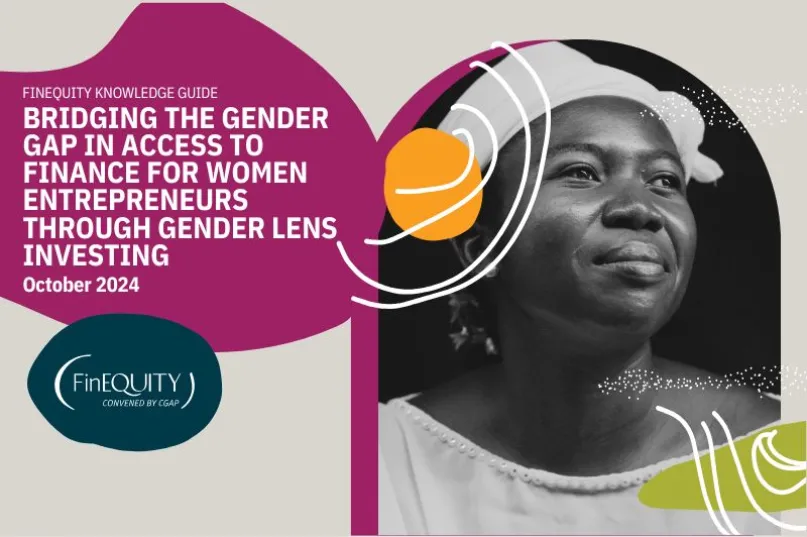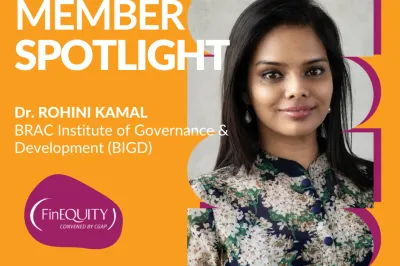FinEquity Knowledge Guide: Bridging the Gender Gap in Access to Finance for Women Entrepreneurs through Gender Lens Investing

Women-led micro, small, and medium enterprises (WMSMEs) play a crucial role in driving economic growth, creating jobs, and promoting innovation globally. However, they continue to face significant challenges in accessing the capital and financial services needed to start or grow their businesses. Financial service providers (FSPs) such as banks, FinTechs, Insurance companies and microfinance institutions (MFIs) can play a significant role in providing access to financial services for WMSMEs, but often fall short due to institutional biases, risk aversion, and a lack of appropriate financial products and services.
Gender Lens Investing (GLI) is an investment approach that intentionally integrates gender-based factors throughout the investment process, aiming to make informed decisions while advancing gender equality. GLI offers a powerful tool for addressing the $1.7 trillion funding gap faced by women-led WMSMEs, - which represents an underserved yet resilient and profitable market segment - while potentially improving financial outcomes for investors. Gender lens investors can tackle this investment gap by directing capital towards FSPs such as banks, FinTechs, and MFIs using a range of tools and strategies. By investing in these FSPs, investors can increase access to finance for women-owned businesses, support the development of tailored financial products, and encourage more inclusive lending practices. This approach not only helps close the financing gap but also recognizes the untapped potential of women-led enterprises, contributing to women's social and economic empowerment while offering attractive investment opportunities.
What is the purpose of this guide?
Drawing on recent publications and industry insights, this FinEquity Knowledge Guide brings together resources to 1) Understand the untapped opportunity that WMSME’s present for investors, donors and development actors given their role in economic growth; 2) Highlight specific frameworks and tools for investors to integrate a gender lens in their investment processes to support FSP’s serving WMSMEs; and 3) Share emerging good practices and case studies in gender lens investing to facilitate industry learning.
Who is this guide for and how can it be used?
The knowledge guide is designed to serve as a quick and valuable reference for investors, donors, and development partners on understanding how they can invest in FSPs to improve their service delivery to WMSMEs:
Impact Investors: Examine the untapped potential of women-led micro, small, and medium enterprises (WMSMEs), while identifying strategies that address the gender investment gap and reviewing successful global GLI initiatives.
Donors and development partners: Recognize the potential of GLI's to advance women's economic empowerment, identify opportunities to scale successful GLI initiatives, and contribute to the evidence base on effective investment strategies for supporting WMSMEs.
Financial Service Providers: Understand how to leverage gender lens investment funds to support women-led micro, small, and medium enterprises. This guide orients FSPs on the impact investors aim to achieve. FSP’s can use this guide in conjunction with other FinEquity guides- Gender Diversity and Leadership Development in Financial Services, Incorporating Gender Intelligent Design in Financial Services, and Gender Data and Analysis.
FinEquity intends to update this knowledge guide periodically with new resources. If you have or come across resources you think should be added, please send them to finequity@cgap.org. For even more resources on this topic, visit FinEquity's Resource Library.
Recommended Resources
The resources in this section emphasize WMSMEs as an underserved market segment. They show how addressing the financial needs of women-owned micro, small, and medium enterprises can help investors, donors, and development actors achieve both financial returns and social impact.
Why invest in women-led micro, small and medium enterprises (WMSMEs)?
The Case for Investing in Women Entrepreneurs
Women Entrepreneurs Financing and Investment (We-FIT) toolkit
The Women Entrepreneurs Financing and Investment (We-FIT) toolkit developed by GIZ, is a comprehensive resource for practitioners, policymakers, and financial institutions to support women-led businesses. It helps users understand the unique challenges and opportunities faced by women entrepreneurs at different stages of their business journey. The toolkit provides validated approaches and strategies to address systemic barriers in the financial system, enabling stakeholders to design effective gender-intelligent investment strategies and learn from successful models that have unlocked financing for WMSMEs.
The resources in this section can help investors, donors, and development actors apply gender-focused approaches when investing in financial service providers that support women-led micro, small, and medium enterprises. They combine industry-standard frameworks with tools developed from investors' gender lens investing experiences.
Frameworks and Tools: How to unlock access to finance for WMSMEs?
2X Criteria
The 2X Criteria, a gender-smart investment and impact assessment framework, has become the global industry standard for gender lens investing. It collaborates with standard-setting bodies and initiatives to ensure broad adoption and alignment with existing frameworks such as GIIN's IRIS+, HIPSO, OECD DAC Gender Equality Policy Marker, and UN Women's Empowerment Principles. As a public good, the 2X Criteria can be used by any investor or financial institution to set targets, self-report alignment, and tag deals as 2X-aligned for internal reporting and tracking. Private sector companies can also assess their practices against the criteria using the 2X Criteria Reference Guide. The 2X criteria and reference guide was updated in January 2024 and includes country and sector-specific benchmark that serve as minimum thresholds for investors and investees. The benchmarks are regularly updated as data becomes available.
Gender Sector Brief: Financial Institutions
This diagnostic guide supports investors and fund managers in identifying gender-smart investment opportunities in the financial institutions (FIs) sector. It provides questions for screening and due diligence, and suggests actions based on the answers. Responsibility for covering gender impact opportunities varies depending on the organization's structure and can be led by investment, ESG, impact, or gender teams. The increasing, and often unmet demand for financial services among women presents a significant business and impact opportunity. Additional information on the rationale and trends in gender-lens investing in FIs is available within the brief.
Gender Equity Assessment Rating (GEAR) Tool
This tool helps investors, asset managers, and advisors evaluate potential financial service provider (FSP) partners on gender integration. GEAR assesses FSPs in five areas: women's client representation, gender-specific products and services, understanding of women's needs, gender-inclusive workplace policies, and women in the workforce and leadership. This framework enables investors to make informed decisions, select partners aligned with gender equity goals, and foster positive change in finance. By guiding investment choices and promoting inclusivity, GEAR allows investors to enhance both social impact and financial performance. The tool ultimately contributes to a more equitable financial ecosystem by identifying strengths and areas for improvement in FSPs' gender integration practices. Investors can use GEAR to maximize their impact on gender equity while pursuing financial returns.
Ilu Toolbox: Forging Diverse, Inclusive and Equal Businesses
This toolbox is a valuable resource for investors conducting gender lens due diligence on potential investees, including financial service providers (FSPs). This toolkit enables investors to assess how companies address gender gaps and promote equality across four dimensions: women in leadership, workplace equality, products and services benefiting women and girls, and equality in the value chain and advocacy. Investors can use the toolbox to evaluate current gender equality practices, identify areas for improvement, and assess the potential impact of gender-focused strategies on a company's competitiveness and societal contribution. For FSP-focused investors, the toolkit offers insights into how these institutions address gender equality in their operations and services. By leveraging this resource, investors can make informed decisions aligned with their gender lens strategies, while encouraging positive change in supported companies, and ultimately contributing to a more inclusive financial ecosystem.
Gender Bonds: A Toolkit for the Design and Issuance of Gender Bonds in Africa
This toolkit provides a comprehensive guide for issuing gender bonds to finance WMSMEs in Africa. It outlines key steps, including defining use of proceeds for gender equality and women's empowerment, establishing project selection criteria for lending to WMSMEs, creating an issuer framework aligned with ICMA principles, obtaining external review, structuring and issuing the bond, and post-issuance monitoring and impact reporting. Gender lens investors, donors and development actors can use this toolkit to understand the gender bond issuance process, evaluate potential investments, provide technical assistance to issuers, anchor or guarantee issuances, and support development of gender bond markets. By following this guidance, stakeholders can help unlock new sources of capital for WMSMEs and advance women's economic empowerment across Africa.
The case studies and reports in this section highlight successful gender lens investing strategies for supporting women-led enterprises. They explore technical assistance, performance incentives, impact-linked finance, and data-driven methods. Investors, donors, and development actors can apply these insights to enhance their own gender-focused investment approaches and implementation.
Lessons Learned: What can stakeholders learn from emerging experiences in gender lens investing to support WMSMEs?
ILU Women's Empowerment Program Technical Assistance Report
The Ilu Women's Empowerment Program offers valuable lessons for impact investors seeking to promote gender equality in Latin America and the Caribbean. By providing tailored technical assistance to investees, the program demonstrated that targeted interventions can lead to significant improvements in gender-smart business practices. Key learnings of the report include the importance of comprehensive training to drive meaningful change, the need to pair education with specific policies and practices, and the critical role of leadership commitment. The program highlighted the value of strong data management systems in enabling gender-focused strategies and emphasized the need for tailored approaches that recognize the diversity among women clients. Impact investors can benefit from this successful model which combines financial investment with customized technical support to accelerate progress towards gender equality in their portfolios.
Breaking Barriers: Harnessing Gender Lens Investments for Sustainable Impact and Inclusive Finance
This FinEquity webinar showcased how leading impact investors, Women's World Banking Asset Management (WAM) and Blue Orchard integrate GLI into their strategies. WAM demonstrated a comprehensive approach, embedding gender considerations throughout their investment process, from portfolio selection to board roles. Blue Orchard presented their custom impact framework, aligning investments with multiple Sustainable Development Goals. The session highlighted how GLI can enhance risk assessment, uncover opportunities, and create long-term value while advancing gender equity. Attendees gained practical insights into operationalizing GLI strategies within inclusive finance, offering valuable lessons for other impact investors seeking to promote women's empowerment through their portfolios.
Promoting Gender Equality through Performance-based Financial Incentives: An Analysis of IDB Invest’s Experience
Gender lens investors, donors, and development actors can gain valuable insights from this report on Performance-Based Incentives (PBIs) in blended finance portfolios. The study conducted by IDB Invest demonstrates how PBIs can effectively increase access to finance for women-led SMEs, boost women's employment opportunities, and help achieve gender targets. It highlights twelve best practices for enhancing gender-focused PBI transactions, including developing sector-specific impact logics, strategic client prioritization, investing in benchmarking, deploying targeted technical assistance, and strengthening learning processes. The report emphasizes the importance of context-specific approaches across different sectors and geographies. By examining real-world case studies, stakeholders can learn how to design and implement effective gender related PBI programs, understand potential challenges, and identify success factors.
Impact Linked Finance Learning Report
Impact investors can learn valuable lessons from this report on Impact-Linked Finance (ILF) published by Roots of Impact. Based on eight years of experience, it demonstrates ILF's potential across various financial instruments and offers key insights for implementation. Investors can gain knowledge on assessing suitability criteria for ILF, applying effective design principles, and leveraging technical assistance to enhance outcomes. The report highlights crucial elements such as establishing baseline projections, ensuring additionality, and appropriate pricing of impact incentives. Impact investors can also learn about emerging trends, including the proposed open-source assessment methodology and integration of impact incentives into funds and technical assistance. The report's advocacy for Impact-Linked Funds for each SDG and Impact-Linked Bonds provides investors with a roadmap for scaling ILF in capital markets. Overall, it offers a comprehensive guide for impact investors to effectively utilize ILF in their investment strategies and contribute to building enabling infrastructure for scale.
A Data-driven Journey in Support of Women’s Financial Inclusion
Investors can glean valuable insights from BII's collaboration with Advans Group on their Gender Action Plan. This report demonstrates how a structured approach to gender-focused initiatives can yield significant results, even during challenging times like the COVID-19 pandemic. Investors can learn the importance of conducting thorough gender diagnostics at both global and local levels to inform strategy. The success in developing gender-differentiated customer profiles and tailored product value propositions in Cameroon and Ghana offers a model for creating targeted financial services. The implementation of a comprehensive Gender Action Plan across subsidiaries showcases the benefits of a systematic approach. The tangible results - a 17.2% increase in women borrowers across African subsidiaries, and higher growth rates in countries with concentrated gender initiatives - provide evidence of the potential impact of such strategies. This case study offers impact investors a blueprint for integrating gender-focused approaches into their investment strategies and measuring concrete outcomes.
Mango Fund Case Study: How a Ugandan Investment Fund Is Doubling the Number of Women-Owned Businesses in Its Portfolio
Mango Fund's success in boosting gender equality within its investment portfolio offers valuable lessons for impact investors, as detailed in this case study. The report demonstrates how the Ugandan impact fund significantly increased its women entrepreneur clientele through strategic interventions, providing a practical model for other financial institutions. Investors can learn about the importance of setting clear gender-related goals and developing comprehensive strategies to achieve them. The study offers insights into improving outreach to women entrepreneurs, which can be applied in different contexts. By highlighting the tangible impact of these interventions, the case study makes a compelling business case for gender-focused investing. Additionally, it addresses specific challenges in lending to women-owned agricultural SMEs, offering solutions that investors can adapt. Overall, this case study serves as a practical guide for impact investors looking to enhance gender equality in their financial operations, providing actionable steps and demonstrating the potential returns of such efforts.


